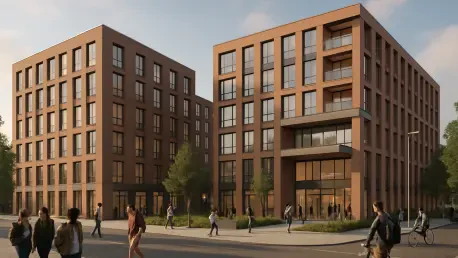In a significant stride toward addressing the escalating demand for student accommodations in urban centers, a major real estate developer has initiated an ambitious project in East London, known as Poland House. This groundbreaking endeavor marks a pivotal moment for Stratford, a rapidly regenerating area with a burgeoning student population. Spearheaded by a prominent investor and developer in collaboration with an experienced contractor, the £50 million development aims to deliver high-quality living spaces tailored to the needs of modern students. With a focus on affordability, sustainability, and community integration, this project promises to set a new standard for purpose-built student accommodation (PBSA) in the region. As urban areas like Stratford continue to evolve into educational and cultural hubs, initiatives like this are crucial for supporting the next generation of learners while contributing to local growth. The strategic location and innovative design of Poland House underscore its potential to become a benchmark in student housing.
A New Chapter for Student Living in Stratford
Poland House, situated on Stratford High Street, is poised to transform the landscape of student housing with its offering of 284 high-quality beds, of which 35% are designated as affordable options. This emphasis on accessibility addresses a critical need in an area where demand for student living spaces continues to outpace supply. Beyond mere accommodation, the development prioritizes an enriched student experience by incorporating amenities such as spacious common rooms, dedicated study zones, and an on-site gym. These features are designed to foster a supportive environment where students can thrive academically and socially. Furthermore, the project’s proximity to key educational institutions, including UCL East and University of the Arts London, both within a 15-minute walk, enhances its appeal. Excellent transport links, with access to Stratford Station and Stratford High Street DLR Station, ensure connectivity across London, making this location ideal for students seeking convenience alongside quality living spaces.
The development of Poland House also reflects a broader trend of investment in student housing within areas undergoing significant urban renewal. Stratford, with its ongoing regeneration and proximity to Queen Elizabeth Olympic Park, stands as a prime example of a locale benefiting from such initiatives. This project is slated for completion ahead of the 2028/29 academic year, providing a timely solution to the growing needs of East London’s student community. Beyond its immediate purpose, the inclusion of a community space for local residents highlights a commitment to fostering positive relationships with the surrounding area. This dual focus on student needs and community engagement sets Poland House apart as a model for future developments. By balancing modern design with practical considerations, the project aims to create a lasting impact on both the educational and social fabric of Stratford, ensuring that it contributes meaningfully to the area’s ongoing transformation into a vibrant urban hub.
Commitment to Sustainability and Quality Design
Sustainability lies at the heart of Poland House, with the project targeting a BREEAM “Excellent” rating, a testament to its alignment with high environmental standards. This focus on green practices is evident in the design and construction processes, which prioritize energy efficiency and eco-friendly materials. Such efforts are not merely about meeting regulatory benchmarks but are part of a broader vision to create enduring, best-in-class assets that benefit both residents and the environment. The collaboration between the developer and contractor brings together expertise in delivering spaces that are not only functional but also forward-thinking in their approach to urban challenges. This shared dedication ensures that Poland House will stand as a sustainable addition to Stratford’s evolving skyline, offering students a living space that reflects contemporary values of environmental responsibility and thoughtful urban planning.
Quality is another cornerstone of this development, with meticulous attention paid to creating vibrant, well-designed spaces that cater to the diverse needs of students. From the layout of individual rooms to the functionality of communal areas, every aspect has been crafted to enhance the living experience. This project represents the third PBSA initiative in the developer’s growing “Living” portfolio, which spans key university cities across the UK, demonstrating a strategic focus on high-quality accommodations. The partnership behind Poland House emphasizes a unified vision of delivering spaces that resonate with both students and the local community. During construction, efforts will be made to engage positively with Stratford residents, minimizing disruption while maximizing the project’s long-term benefits. This holistic approach to development underscores a commitment to not just building structures, but creating environments where people can connect, grow, and thrive in harmony with their surroundings.
Building for the Future of Urban Communities
Reflecting on the impact of Poland House, it’s clear that this initiative goes beyond merely addressing a housing shortage; it redefines what student accommodation can achieve in terms of community integration. The groundbreaking in Stratford marks the beginning of a journey that balances educational needs with urban renewal, setting a precedent for future projects. The strategic foresight in choosing a location with robust transport links and proximity to academic institutions ensures that the development meets immediate practical demands while contributing to the area’s long-term growth. Partnerships like the one driving this project prove instrumental in executing a vision that prioritizes both innovation and responsibility, leaving a lasting footprint on East London’s landscape.
Looking ahead, the completion of Poland House offers a blueprint for tackling similar challenges in other urban centers facing student housing deficits. Stakeholders in the real estate and education sectors might consider replicating this model, focusing on affordability and sustainability as core principles. Exploring further collaborations between developers and contractors with aligned values could accelerate the delivery of such impactful projects. Additionally, policymakers could draw inspiration from this development to incentivize community-focused designs in future urban planning efforts. As Stratford continues to evolve, the legacy of Poland House will likely inspire a wave of student accommodations that prioritize not just shelter, but a holistic approach to living and learning in dynamic city environments.









